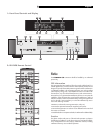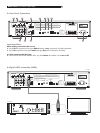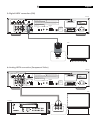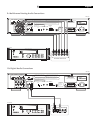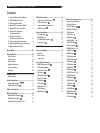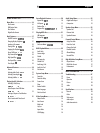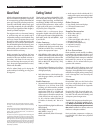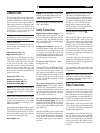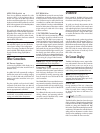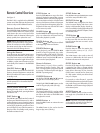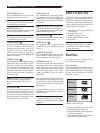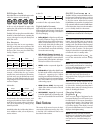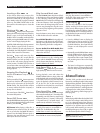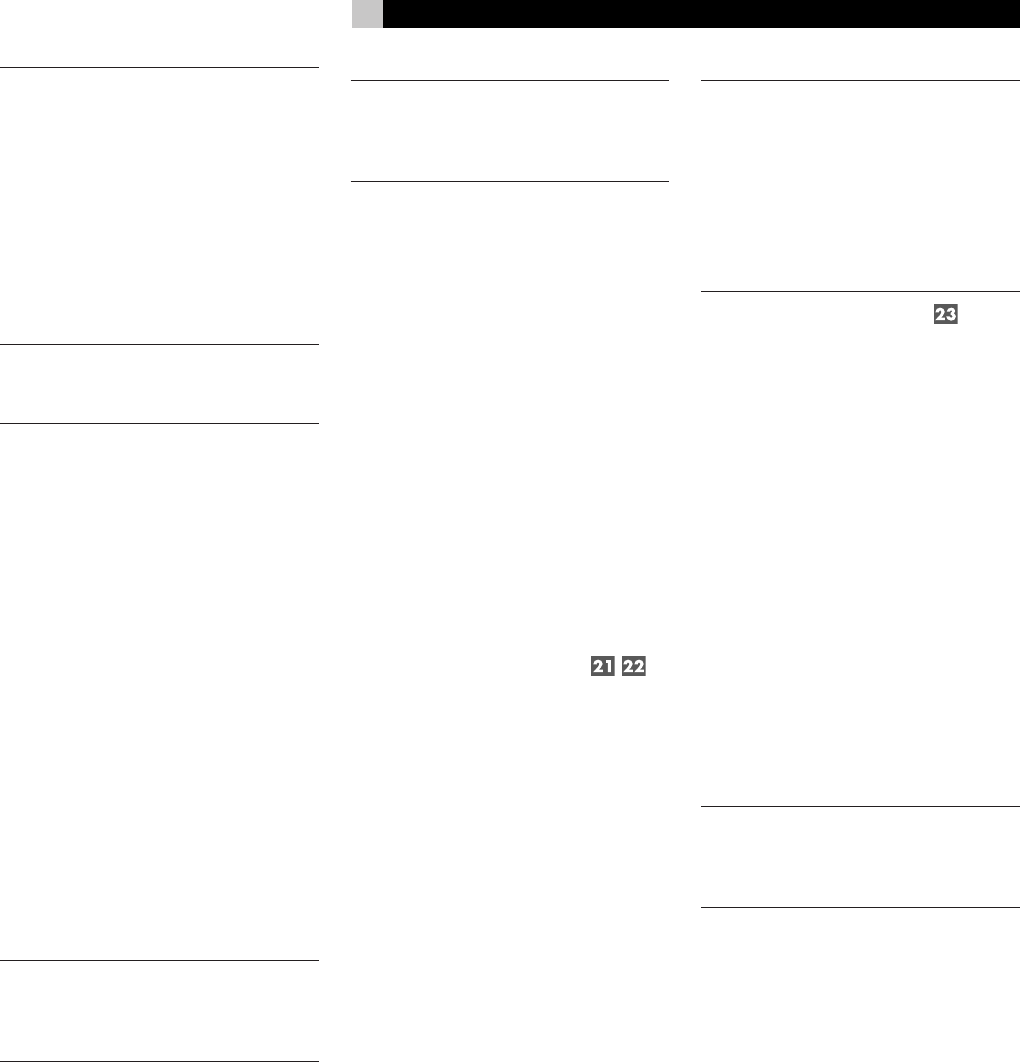
11
English
CONNECTIONS
This section describes the back-panel connec-
tions and settings that must be made during
installation of the RDV-1093. These include the
power connection, audio output connections,
video output connections, and selecting of the
video standard for your TV. In addition, there
are optional connections for an external IR
remote signal, a +12V turn-on trigger, and
an I/O port for computer control.
NOTE: To prevent loud noises, make sure
the DVD player and the rest of the system is
turned off when making connections.
Cable Selection
Use standard audio cables with RCA connec-
tors for analog audio connections. Use the
following color code:
Left channel audio: white
Right channel audio: red
Choose from three different types of analog
video cables. For composite video, use a single
75 ohm video cable with an RCA connector
at each end. For S-Video, use an S-Video
cable with a special multi-pin connector at
each end. For component video, use a set
of three matching 75 ohm video cables with
RCA connectors at each end. Use the following
standard color code:
Composite video: yellow
Component video (Y): green
Component video (PB): blue
Component video (PR): red
NOTE: Do not use standard audio cables in
place of 75 ohm video cables. Audio cables
will usually pass the signal, but will degrade
the quality.
Choose from two different types of digital
video cables. For connection to a TV or video
processor with an HDMI input, use an HDMI
cable. For connection to a DVI input, use an
HDMI-to-DVI cable.
Use standard optical digital cables for optical
digital signals. Be sure to remove the protective
covers from the ends of the cable. Use 75 ohm
digital audio cables with an RCA connector
on each end for coax digital audio.
Coax digital: black
NOTE: You can substitute a 75 ohm video
cable for a coax digital cable, but do not
substitute conventional audio interconnect
cables for digital signals.
When making signal connections, follow the
color codes carefully.
Audio Connections
Digital audio outputs supply an un-
decoded digital audio signal for use with
a surround processor’s decoding and D/A
converters. This is the preferred connection
when using the RDV-1093 with a Dolby Digital/
DTS surround processor.
Analog audio outputs supply up to 5.1
channels of decoded analog audio. Use these
connections when connecting the RDV-1093
to a receiver or TV set that does not have its
own Dolby Digital and DTS decoding, or for
passing multichannel DVD-Audio PCM signals
to the analog inputs of a receiver.
Analog Audio Outputs
See Figure 8 and 9
Two sets of RCA jacks, labeled ANALOG OUT
sends either six channels of decoded analog
audio (front left, front right, rear left, rear
right, center, and subwoofer) or two channels
of stereo analog audio from the RDV-1093 to
the analog audio inputs of an audio surround
processor, preamplifier, integrated amplifier,
receiver or TV set.
To a surround processor with 5.1
channel inputs, use RCA audio cables to
connect the six outputs labeled 5.1CH to the
matching multichannel inputs on the surround
processor (L to front left, R to front right, LS to
left surround, RS to right surround, C to center
channel, SUB to subwoofer, etc.)
To a stereo preamp, processor, or TV
set with 2-channel inputs, use the pair
of RCA outputs labeled STEREO. Connect the
STEREO L output to the left audio input of the
TV or receiver and the STEREO R output to the
right audio input.
Typically, the STEREO outputs send a matrix
encoded stereo signal to the surround processor.
See the Speaker Size topic in the Setup section
of this manual for information on matching
the analog output signal to your preamp or
processor.
NOTE: The analog audio outputs are typi-
cally used only with DVD-Audio discs or
with surround processors or TV sets that do
not have Dolby Digital or DTS processing. If
your processor has Dolby Digital and DTS
decoding, you will not need to make any
analog audio connections to play video
DVDs; one digital connection (described in
the following section) will suffice.
Digital Audio Outputs
See Figure 10
The RDV-1093’s digital outputs provide a
digital audio bitstream, which must be used
with a processor that accepts a digital signal
and has its own Dolby Digital and/or DTS
decoding. There are two types of outputs for
the digital audio signal: an optical output and
a coaxial output. Use whichever you prefer.
If you choose the optical connection, remove
the plastic cap protecting the connector and
save it for future use.
Connect the cable of your choice (optical or
coaxial) from the DIGITAL OUT connectors of
the RDV-1093 to the matching digital input on
the surround processor.
You will probably need to select the correct
digital input on your surround processor, using
its setup menus.
NOTE: See the Audio Setup Menu in the
Setup section of this manual for information
on selecting the right type of digital output
signal for your processor.
Video Connections
Video outputs send the video signal from the
DVD player to the surround processor, video
processor, or TV set. A key feature of the
RDV-1093 is that it can send a video signal to
any high definition or standard definition TV
monitor in exactly the format that best matches
the native mode and resolution of the TV.
Digital HDTVs, such as LCD and plasma flat
screens, display digital signals directly. These
TVs should be connected to the RDV-1093
using the HDMI digital output.
Analog HDTVs, such as CRT and rear-projec
-
tion sets, display analog signals. Although
these can be connected with an HDMI cable
these TVs should generally be connected with
analog Component Video cables to avoid
an unnecessary digital-to-analog conversion
in the TV.



